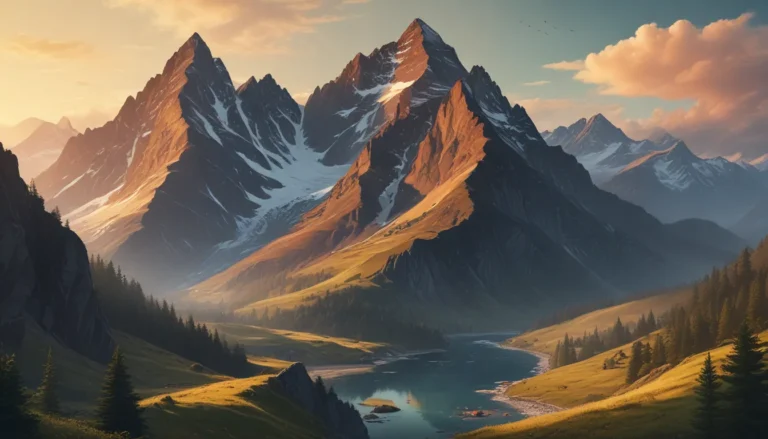A Note About Images: The images used in our articles are for illustration purposes only and may not exactly match the content. They are meant to engage readers, but the text should be relied upon for accurate information.
Welcome to a world where sound paints the landscapes with its melodies and echoes, shaping the very essence of our geography. From the roaring oceans to the whispering forests, the Earth is a natural orchestra, captivating us with its diverse and mesmerizing sounds. In this article, we will embark on a journey to uncover 16 unbelievable facts about sound in geography that will leave you in awe of its power and intricacies. Let’s delve into the wondrous world of sound and explore the remarkable auditory wonders that define our planet.
The Earth as a Symphony
Imagine the Earth as a grand symphony, with each geographical feature contributing its unique harmony to the ensemble. From the booming dunes of the Sahara to the melodic whalesongs in the oceans, our planet showcases an incredible diversity of sounds that captivate and inspire. Nature’s musical wonders are all around us, reminding us of the beauty and complexity of the world we inhabit.
The Loudest Place on Earth
In the depths of the Pacific Ocean lies the Mariana Trench, a geographical marvel that claims the title of the loudest place on Earth. With tectonic plates shifting and moving at unimaginable depths, the Mariana Trench produces an incredibly loud sound that resonates through the waters, reminding us of the immense power and dynamics of our planet.
Nature’s Unique Phenomena
From the sands of the Gobi Desert to the caves of Iceland, nature’s geographical features often hide mysterious sounds waiting to be discovered. The singing sands of the deserts and the whistling caves of Iceland offer a glimpse into the magical world of acoustic wonders, showcasing the Earth’s ability to surprise and delight us with its auditory treasures.
The Enchanting Underwater Symphony
Beneath the waves of the Great Barrier Reef in Australia, a vibrant underwater symphony unfolds. The clicks and calls of marine creatures, the gentle waves, and the creaking of coral create a mesmerizing soundscape that reflects the rich biodiversity and beauty of this marine wonderland.
Exploring Natural Echoes
In the vast expanses of the Grand Canyon in Arizona, echoes have a playground to bounce and reverberate, creating a remarkable auditory experience for visitors. The unique rock formations and sheer size of the canyon make it a perfect environment for sound to travel and echo, amplifying the natural beauty and grandeur of this geological wonder.
A Serenade from the Deep
Geographically dispersed across the oceans are majestic creatures known for their enchanting songs – whales. These melodic giants communicate through intricate patterns and vocalizations, creating a symphony of sounds that travel vast distances and fill the underwater world with their haunting melodies.
The Power of Volcanic Roars
Volcanoes, with their explosive eruptions and rumbling nature, generate intense sounds that reverberate through the earth. From the deep rumble of dormant volcanoes to the explosive roar of active eruptions, these geological wonders remind us of the raw power and energy that lies beneath the Earth’s surface.
The Melodic Dance of Icebergs
In the icy landscapes of polar regions, the cracking and shifting of icebergs create a symphony of eerie pops, creaks, and rumbles. These massive chunks of ice tell a story of the dynamic and ever-changing nature of our planet’s icy landscapes, inviting us to listen to the whispers of the frozen world.
The Majesty of Thunderstorms
Thunderstorms bring a display of nature’s power and beauty, with their loud cracks of thunder and dazzling streaks of lightning illuminating the sky. The deep rumbles and resonating sounds of thunder echo through the landscape, leaving us in awe of the grandeur and magnificence of these natural phenomena.
The Hidden Songs of the Desert
In the vast deserts of Namibia, sand dunes sing a haunting melody as the wind dances across their slopes. The echoes of a distant choir can be heard in the humming sands, creating a surreal and enchanting ambiance that reflects the mystique and beauty of these arid landscapes.
Unveiling Geological Chimes
The rock towers of Zhangjiajie in China, known for their resemblance to the movie “Avatar,” have a hidden talent – they emit a musical chiming sound when struck. This geological oddity, attributed to the unique composition of the sandstone pillars, adds a touch of whimsy and wonder to these already captivating landscapes.
The Symphony of Waterfalls
Waterfalls like the iconic Niagara Falls create a powerful and resonant sound as they cascade down steep cliffs. The thunderous roar of the rushing water echoes through the valleys, reminding us of the raw energy and force of nature that shapes the landscape around us.
Whispering Bamboo Forests
In the serene bamboo forests of Southeast Asia, the rustling of the tall stalks creates a soothing and gentle sound that adds to the peaceful ambiance of these picturesque landscapes. The wind weaves through the slender bamboo, creating a symphony of rustling leaves that whispers stories of tranquility and beauty.
Mysteries of the Mojave Desert
In California’s Mojave Desert, humming sand dunes add a touch of mystery to the already enchanting landscape. When sand particles move, these dunes emit a peculiar humming sound known as the “booming dunes,” leaving visitors enchanted and curious about the secrets hidden within these shifting sands.
Revisiting the Symphony of Sound
As we conclude our journey into the world of sound in geography, we are reminded of the incredible diversity and beauty that surrounds us. From the depths of the oceans to the heights of the mountains, sound shapes the landscapes and experiences that define our planet.
Answering Your Questions
- How does sound affect geography?
-
Sound plays a crucial role in shaping geography, influencing phenomena like erosion, landform creation, and the mapping of topography.
-
Can sound travel through different types of terrain?
-
Yes, sound can travel through various terrains, with the speed and distance varying depending on the medium and geographical features.
-
How fast does sound travel?
-
The speed of sound varies depending on the medium, with an average speed of approximately 343 meters per second in dry air at room temperature.
-
Can sound be used for underwater exploration?
-
Yes, sound is commonly used in underwater exploration through technologies like sonar, which rely on sound waves to map the ocean floor and detect underwater objects.
-
How does sound contribute to geographic phenomena like echo or reverberation?
- Echoes and reverberations are influenced by the geography and architectural elements of an environment, with sound waves bouncing off surfaces or reflecting multiple times within enclosed spaces.
Trustworthy and Engaging Content
At Nzgeo.com, our mission is to share trustworthy and engaging content that reflects the diverse insights and information contributed by real users like you. Our editors work diligently to ensure the accuracy and authenticity of each fact, guaranteeing a high standard of quality in every piece of content we deliver. Explore and learn with us as we continue to uncover the wonders of our world through the lens of geography and sound.






